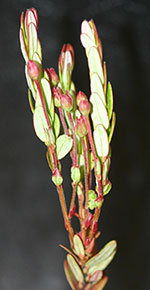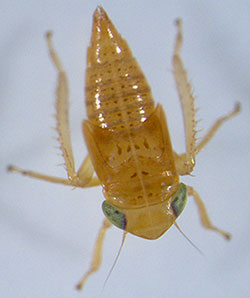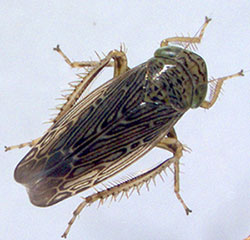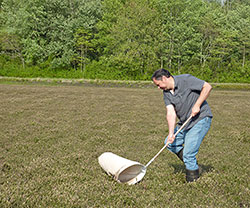Fact Sheet FS1248

Figure 1.
The blunt-nosed leafhopper, Limotettix vaccinii (Van Duzee) (Hemiptera: Cicadellidae), is a sucking insect that feeds on plant sap. Although the insect may cause direct damage to plants, it is mainly a concern because it transmits a phytoplasma that causes cranberry false blossom disease. False blossom is characterized by a malformation of the flowers. The flowers stand erect and there is no production of fruit, with devastating effects for cranberry yield. Diseased plants produce their uprights close together, forming a witches' broom, and turn reddish earlier in the fall than healthy plants (Figure 1). Cranberry false blossom threatened the entire cranberry industry in the early 1900's. The disease was most problematic in New Jersey, where the cranberry industry was almost eliminated.
Distribution

Figure 2.
Blunt-nosed leafhopper ranges from Nova Scotia and Quebec in Canada south into New Jersey and Maryland and west into Minnesota and Iowa in the U.S. It is not found on cranberry bogs of the Pacific Coast, and is seldom seen on commercial bogs in Massachusetts, although it occurs in Massachusetts in wild and abandoned cranberry bogs. False blossom disease was almost extinct in the second half of the last century. However, changes in pest management practices, i.e., lower usage of insecticides as well as switching from broad-spectrum insecticides to more target-specific compounds, have caused an increase in populations of blunt-nosed leafhopper in New Jersey cranberries in the last few years. The insect can become established in areas where insecticides are eliminated, followed by symptoms of false blossom disease. The leafhopper has several host plants besides cranberry, all in the family Ericaceae, including fetterbush, leatherleaf, and dwarf huckleberry. The insect does not move around much and colonization of bogs occurs slowly.
Life Cycle and Identification

Figure 3.
The insect completes one generation a year and overwinters as an egg. The eggs are cylindrical with rounded ends, waterywhitish in color, and about 1mm (1/32") long. They are generally laid lengthwise under the bark of the more tender parts of the cranberry stem. In New Jersey, nymphs appear by mid-May. The wingless nymphs go through five instars in 1–2 months. At first they are whitish and about 1.5mm (1/16") long. Their color varies as they grow, some being yellow, some blackish, and some greenish-gray (Figure 2). The adults appear by the end of June, males emerging a few days before the females. They are most abundant in July, and numbers start to diminish by the end of July. The winged adults have a characteristic blunt head and vary from light yellowish-gray to dark brown (Figure 3). The female averages 4mm (5/32") in length and males are a little smaller.
Management

Figure 4.
Blunt-nosed leafhopper occurs mainly on certain cranberry varieties, such as Howes, Centennial, and most native Jerseys, rather than on Early Black or McFarlin. The most important point in its control is locating the infestation. Monitoring for this insect is accomplished best with an insect sweep net (Figure 4). Flooding was listed as an effective method to control the leafhoppers in the past, but is not used now due to the risk of serious injury to the rapidly growing plants. It is recommended to apply chemical control with broad-spectrum insecticides against leafhopper nymphs before bloom, but post-bloom application against adults is also possible. Neonicotinoids are also very effective against blunt-nosed leafhopper, but their use should be restricted to post-bloom applications due to their potential negative impact on bees. There is no sweep net threshold, so decisions should be made based on current population size and prior history of infestation. Broad-spectrum insecticides applied pre-bloom may disrupt biological control, in particular for Sparganothis fruitworm, so their use should be limited to those areas of high blunt-nosed leafhopper populations.
Literature Cited
Photo credits: Dan Schiffhauer, Ocean Spray Cranberries, Inc. (Figure 1) and Elvira de Lange, Department of Entomology, Rutgers University (Figures 2–4).
November 2015
Copyright © 2025 Rutgers, The State University of New Jersey. All rights reserved.
For more information: njaes.rutgers.edu.
Cooperating Agencies: Rutgers, The State University of New Jersey, U.S. Department of Agriculture, and Boards of County Commissioners. Rutgers Cooperative Extension, a unit of the Rutgers New Jersey Agricultural Experiment Station, is an equal opportunity program provider and employer.

